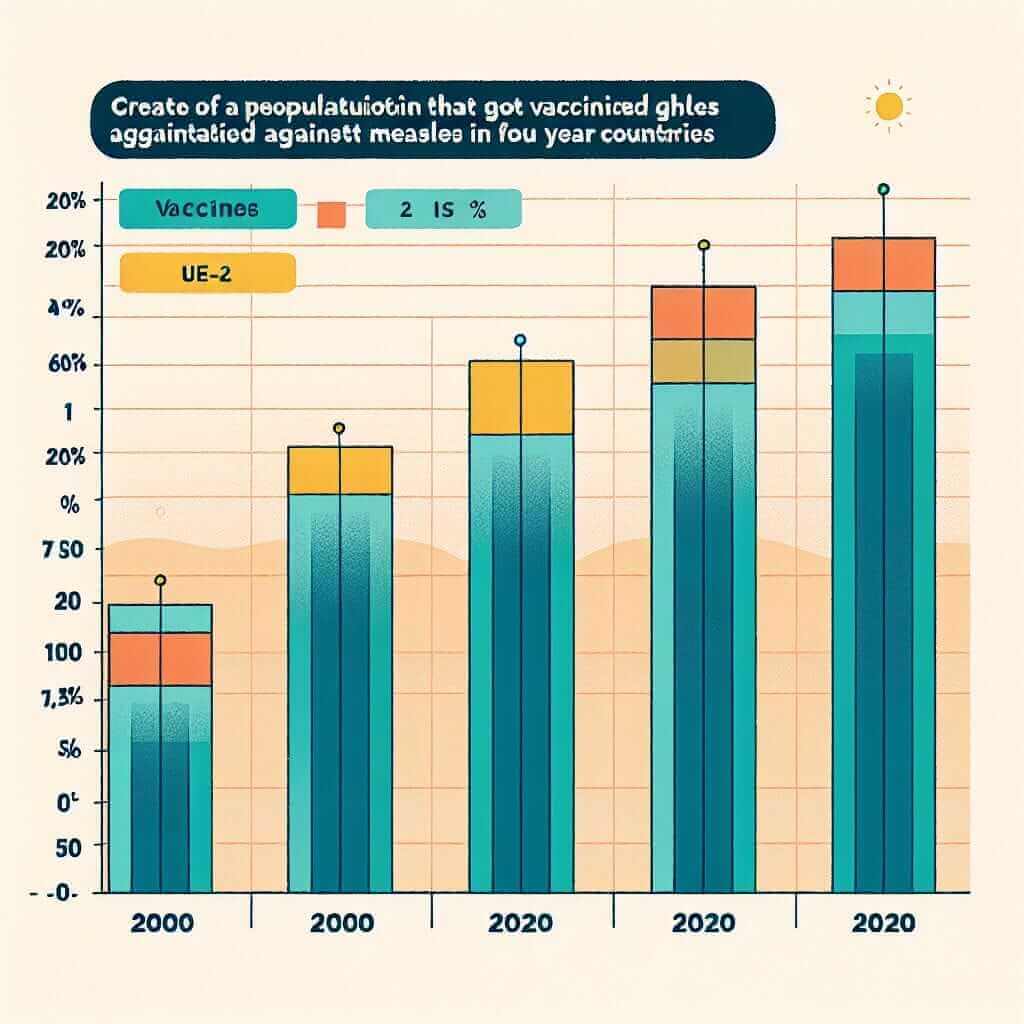The IELTS Writing Task 1 often presents data on global trends, and “Vaccination Rates by Country” is a recurring theme. This topic requires a keen understanding of data interpretation, vocabulary related to health and statistics, and the ability to present complex information coherently.
Nội dung bài viết
Let’s delve into how you can master this type of IELTS question.
Sample IELTS Writing Task 1 Question
You should spend about 20 minutes on this task.
The chart below shows the percentage of the population vaccinated against measles in four different countries from 2000 to 2020.
Summarise the information by selecting and reporting the main features, and make comparisons where relevant.
(Insert a realistic bar chart depicting measles vaccination rates in four countries over the specified period. The data should show variations in trends and vaccination coverage.)

Data Analysis and Interpretation
Before writing, carefully analyze the provided chart:
- Identify the variables: The chart displays the percentage of vaccination coverage on the Y-axis and the years (2000-2020) on the X-axis.
- Note the trends: Observe how vaccination rates have changed over time in each country. Are there any significant increases or decreases?
- Compare and contrast: Look for similarities and differences in the vaccination trends across the four countries.
Model Answer
The bar chart illustrates the proportion of individuals immunized against measles in four distinct countries spanning two decades, from 2000 to 2020.
Overall, vaccination rates for measles have generally risen across all four nations over the twenty-year period. However, disparities in coverage and the rate of improvement are evident.
In Country A, vaccination coverage remained consistently high, fluctuating between 90% and 95% throughout the period. Similarly, Country B demonstrated a steady increase, starting at approximately 75% in 2000 and reaching nearly 90% by 2020.
Country C exhibited a more dramatic trend. Starting at a low rate of about 60% in 2000, vaccination coverage surged to 85% by 2010, eventually reaching a plateau around 90% in the latter decade.
Conversely, Country D lagged behind the others. Despite a gradual increase from 50% to 70% between 2000 and 2015, its vaccination rate remained the lowest among the four countries by 2020.
(Word count: 154 words)
Key Considerations for IELTS Writing Task 1
- Paraphrasing: Avoid simply copying the question’s language. Use synonyms like “illustrates,” “proportion,” and “immunized” to demonstrate vocabulary range.
- Overview: Provide a clear and concise overview of the main trends in the first paragraph.
- Data Selection: Focus on the most significant data points and trends. Avoid describing every single detail.
- Comparisons: Make relevant comparisons between countries and highlight any noticeable differences.
- Accurate Language: Use appropriate vocabulary to describe trends, such as “fluctuated,” “steady increase,” “surged,” and “lagged behind.”
- Grammar and Cohesion: Ensure your writing is grammatically accurate and use cohesive devices to connect ideas smoothly.
Essential Vocabulary for Vaccination Rates
- Vaccination rate/coverage (n.) /ˌvæk.səˈneɪ.ʃən ˌreɪt/ /ˈkʌv.ər.ɪdʒ/: The percentage of a population that has been vaccinated against a particular disease.
- Immunization (n.) /ˌɪm.jə.nəˈzeɪ.ʃən/: The process of making someone immune to a disease, typically by vaccination.
- Prevalence (n.) /ˈprev.əl.əns/: The fact or condition of being common.
- Trend (n.) /trend/: A general direction in which something is developing or changing.
- Surge (v.) /sɝːdʒ/: To increase suddenly and powerfully.
- Plateau (n.) /plæˈtoʊ/: A state of little or no change following a period of activity or progress.
- Lag behind (v.) /læɡ bɪˈhaɪnd/: To make slower progress than others.
- Disparity (n.) /dɪˈspær.ə.t̬i/: A great or noticeable difference between two things.
- Administer (v.) /ədˈmɪn.ɪ.stər/: To give or apply (something, such as a treatment or drug) to someone.
- Herd immunity (n.) /hɝːd ɪˈmjuː.nə.t̬i/: Resistance to the spread of an infectious disease within a population that results if a sufficiently high proportion of individuals are immune to the disease, especially through vaccination.
Conclusion
Mastering the art of analyzing and writing about vaccination rates is crucial for success in the IELTS Writing Task 1. By understanding the key vocabulary, data interpretation techniques, and writing conventions, you can confidently tackle this type of question and achieve your desired band score. Remember to practice regularly with sample questions and seek feedback to refine your skills.